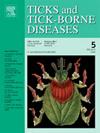大型有蹄类食草动物对新森林中蓖麻伊蚊和蜱传病原体的作用——未来野生景观的一个案例研究
IF 3.4
2区 医学
Q2 INFECTIOUS DISEASES
引用次数: 0
摘要
大型有蹄类食草动物可以通过保护性放牧来管理栖息地,这是一种利用牲畜来控制植被生长的做法,具有许多生态效益,但有可能为蜱虫提供额外的宿主,从而对蜱传疾病的风险产生影响。牛和羊被怀疑是几种蜱传播病原体的传播宿主,因此牲畜的存在可能会增加疾病危害。然而,一些有蹄类物种不传播其他病原体,如伯氏疏螺旋体(s.l),因此保护性放牧可以通过转移蜱对传播宿主的摄食来减少这些病原体的流行,从而减少环境疾病危害。为了更好地理解这些动态,我们在英格兰南部的新森林进行了配对实验。在2021年至2023年期间,在20个地点收集了探询蜱。10个地点位于“圈地”(新森林术语,指用围栏围起来的林地,以排除牲畜)内,其余10个地点没有围栏,允许放牧牲畜。放牧导致地面植被明显缩短,寻找蓖麻伊蚊若虫数量减少。我们对2974个若虫进行了多种病原体的检测,发现不同地点的伯氏疏螺旋体和嗜吞噬细胞无原体的若虫感染流行率和感染密度没有显著差异。然而,我们发现,在放牧的地方,感染的加里氏疏螺旋体和瓦莱西氏疏螺旋体的若虫密度较低。在本研究中,我们发现小马和牛的保护性放牧可能通过影响植被下层植被来降低蜱虫密度,并且可能降低某些伯氏疏螺旋体基因种的疾病危害,但对嗜吞噬细胞螺旋体没有作用。本文章由计算机程序翻译,如有差异,请以英文原文为准。

The role of large ungulate grazers on Ixodes ricinus and tick-borne pathogens in the New Forest - a case study for future rewilded landscapes
Large ungulate grazers can manage habitats via conservation grazing, a practice using livestock to control vegetation growth, which has many ecological benefits but has the potential to provide additional hosts for ticks and consequently have an impact on tick-borne disease risk. Cattle and sheep are suspected to be transmission hosts for several tick-transmitted pathogens, so the presence of livestock could increase disease hazard. However, some ungulate species do not transmit other pathogens such as Borrelia burgdorferi sensu lato (s.l.), so conservation grazing could reduce prevalence of these pathogens, and thus environmental disease hazard, by diverting ticks from feeding on transmission hosts. To better understand these dynamics, we used a paired experiment in the New Forest in southern England. Questing ticks were collected at 20 sites between 2021 and 2023. Ten sites were inside “inclosures” (New Forest term for fenced woodlands to exclude livestock) and the remaining ten were not fenced, which permitted livestock grazing. Grazing led to significantly shorter ground vegetation and fewer questing Ixodes ricinus nymphs. We tested 2974 nymphs for multiple pathogens and determined there were no significant differences in nymphal infection prevalence or density of infected nymphs for B. burgdorferi s.l. and Anaplasma phagocytophilum between sites. However, we found that the density of infected nymphs for Borrelia garinii and Borrelia valaisiana was lower where there was grazing. In this study, we show that conservation grazing by ponies and cattle could lower tick density, probably by affecting the vegetation understory, and could potentially lower disease hazard for some genospecies of B. burgdorferi s.l. but not A. phagocytophilum.
求助全文
通过发布文献求助,成功后即可免费获取论文全文。
去求助
来源期刊

Ticks and Tick-borne Diseases
INFECTIOUS DISEASES-MICROBIOLOGY
CiteScore
6.90
自引率
12.50%
发文量
185
审稿时长
6-12 weeks
期刊介绍:
Ticks and Tick-borne Diseases is an international, peer-reviewed scientific journal. It publishes original research papers, short communications, state-of-the-art mini-reviews, letters to the editor, clinical-case studies, announcements of pertinent international meetings, and editorials.
The journal covers a broad spectrum and brings together various disciplines, for example, zoology, microbiology, molecular biology, genetics, mathematical modelling, veterinary and human medicine. Multidisciplinary approaches and the use of conventional and novel methods/methodologies (in the field and in the laboratory) are crucial for deeper understanding of the natural processes and human behaviour/activities that result in human or animal diseases and in economic effects of ticks and tick-borne pathogens. Such understanding is essential for management of tick populations and tick-borne diseases in an effective and environmentally acceptable manner.
 求助内容:
求助内容: 应助结果提醒方式:
应助结果提醒方式:


